Soil Water and Salt Transport in Severe Saline–Alkali Soil after Ditching under Subsurface Pipe Drainage Conditions
Abstract
:1. Introduction
2. Materials and Methods
2.1. Study Region
2.2. Experimental Design
2.3. DRAINMOD-S Model
2.3.1. Model Fundamentals and Input Data
2.3.2. Calibration and Validation of the DRAINMOD-S Model
3. Results
3.1. The Law of Soil Moisture Migration under Ditching Conditions in Different Subsurface Pipe Plots
3.2. Desalination Law of Soil under Ditching Conditions in Different Subsurface Pipe Plots
3.3. DRAINMOD-S Simulated Soil Water and Salt Transport under Different Ditching Depths
4. Discussion
4.1. The Effects of Different Spacing and Buried Depth of Subsurface Pipes on Soil Water and Salt Transport under Ditching Conditions
4.2. The Effect of Ditching Depth on Water and Salt Transport under Subsurface Drainage Conditions
5. Conclusions
- Under the same buried pipe layout parameters, the drainage volume per unit area of the ditching plot increased by an average of 14.65% compared to that of the non-ditching plot. The soil water storage capacity was also significantly reduced. This disparity in soil water storage from the surface to the deep layers was between 0.94 mm and 0.98 mm.
- Under the same arrangement parameters of the subsurface pipe, the implementation of ditching significantly improved the soil salt-leaching effect of the subsurface pipes. The most significant effect was observed on the desalination rate of the surface soil, where it increased by 13.40% in the 0–20 cm soil layer.
- An increase in ditching depth improved the drainage and salt discharge capacity of the subsurface pipes. However, when the buried depth of the subsurface pipes reached a certain threshold (1.3 m in this study), the improved leaching effect of the subsurface pipes owing to ditching became independent of the ditching depth.
Author Contributions
Funding
Institutional Review Board Statement
Informed Consent Statement
Data Availability Statement
Conflicts of Interest
Abbreviation
| EC1:5 | 1:5 soil-to-water ratio basis |
| ET | evapotranspiration |
| R2 | decisive coefficient |
| MAE | mean absolute error |
| RMSE | root mean square error |
References
- Metternicht, G.I.; Zinck, J. Remote sensing of soil salinity: Potentials and constraints. Remote Sens. Environ. 2003, 85, 1–20. [Google Scholar] [CrossRef]
- Srivastava, P.; Wu, Q.-S.; Giri, B. Salinity: An overview. In Microorganisms in Saline Environments: Strategies and Functions; Springer: Berlin, Germany, 2019; pp. 3–18. [Google Scholar] [CrossRef]
- Dou, X.; Shi, H.B.; Li, R.P.; Miao, Q.F.; Tian, F.; Yu, D.D.; Zhou, L.Y.; Wang, B. Effects of controlled drainage on the content change and migration of moisture, nutrients, and salts in soil and the yield of oilseed sunflower in the Hetao Irrigation District. Sustainability 2021, 13, 9835. [Google Scholar] [CrossRef]
- Feng, Z.Z.; Miao, Q.F.; Shi, H.B.; Feng, W.Y.; Li, X.Y.; Yan, J.W.; Liu, M.H.; Sun, W.; Dai, L.P.; Liu, J. Simulation of water balance and irrigation strategy of typical sand-layered farmland in the Hetao Irrigation District, China. Agric. Water Manag. 2023, 280, 108236. [Google Scholar] [CrossRef]
- Feng, W.Y.; Yang, F.; Cen, R.; Liu, J.; Qu, Z.Y.; Miao, Q.F.; Chen, H.Y. Effects of straw biochar application on soil temperature, available nitrogen and growth of corn. J. Environ. Manag. 2021, 277, 111331. [Google Scholar] [CrossRef] [PubMed]
- Zhou, L.X.; Liu, W.; Duan, H.J.; Dong, H.W.; Li, J.C.; Zhang, S.X.; Zhang, J.; Ding, S.G.; Xu, T.Y.; Guo, B.B. Improved effects of combined application of nitrogen-fixing bacteria Azotobacter beijerinckii and microalgae Chlorella pyrenoidosa on wheat growth and saline-alkali soil quality. Chemosphere 2023, 313, 137409. [Google Scholar] [CrossRef] [PubMed]
- Xiao, L.G.; Wei, X.; Wang, C.Y.; Zhao, R.Q. Plastic film mulching significantly boosts crop production and water use efficiency but not evapotranspiration in China. Agric. Water Manag. 2023, 275, 108023. [Google Scholar] [CrossRef]
- Askri, B.; Khodmi, S.; Bouhlila, R. Impact of subsurface drainage system on waterlogged and saline soils in a Saharan palm grove. Catena 2022, 212, 106070. [Google Scholar] [CrossRef]
- Sazawa, K.; Komiyama, T.; Tsuchida, T.; Taguchi, R.; Nakashima, F.; Ohta, T.; Nishio, M.; Yamazaki, Y.; Kuramitz, H. Effects of paddy irrigation-drainage system on water quality and productivity of small rivers in the Himi region of Toyama, Central Japan. J. Environ. Manag. 2023, 342, 118305. [Google Scholar] [CrossRef]
- He, X.L.; Liu, H.G.; Ye, J.Y.; Yang, G.; Li, M.S.; Gong, P.; Aimaiti, A. Comparative investigation on soil salinity leaching under subsurface drainage and ditch drainage in Xinjiang arid region. Int. J. Agric. Biol. Eng. 2016, 9, 109–118. [Google Scholar] [CrossRef]
- Konukcu, F.; Gowing, J.W.; Rose, D.A. Dry drainage: A sustainable solution to waterlogging and salinity problems in irrigation areas? Agric. Water Manag. 2006, 83, 1–12. [Google Scholar] [CrossRef]
- Haj-Amor, Z.; Bouri, S. Subsurface drainage system performance, soil salinization risk, and shallow groundwater dynamic under irrigation practice in an arid land. Arab. J. Sci. Eng. 2018, 44, 467–477. [Google Scholar] [CrossRef]
- Qian, Y.Z.; Zhu, Y.; Ye, M.; Huang, J.S.; Wu, J.W. Experiment and numerical simulation for designing layout parameters of subsurface drainage pipes in arid agricultural areas. Agric. Water Manag. 2021, 243, 106455. [Google Scholar] [CrossRef]
- Ghane, E.; Askar, M.H.; Skaggs, R.W. Design drainage rates to optimize crop production for subsurface-drained fields. Agric. Water Manag. 2021, 257, 107045. [Google Scholar] [CrossRef]
- Tao, Y.; Wang, S.; Xu, D.; Qu, X. Experiment and analysis on flow rate of improved subsurface drainage with ponded water. Agric. Water Manag. 2016, 177, 1–9. [Google Scholar] [CrossRef]
- Tao, Y.; Wang, S.; Xu, D.; Yuan, H.; Chen, H. Field and numerical experiment of an improved subsurface drainage system in Huaibei plain. Agric. Water Manag. 2017, 194, 24–32. [Google Scholar] [CrossRef]
- Dou, X.; Shi, H.B.; Li, R.P.; Miao, Q.F.; Yan, J.W.; Tian, F.; Wang, B. Simulation and evaluation of soil water and salt transport under controlled subsurface drainage using HYDRUS-2D model. Agric. Water Manag. 2022, 273, 107899. [Google Scholar] [CrossRef]
- Moursi, H.; Youssef, M.A.; Poole, C.A.; Castro-Bolinaga, C.F.; Chescheir, G.M.; Richardson, R.J. Drainage water recycling reduced nitrogen, phosphorus, and sediment losses from a drained agricultural field in eastern North Carolina, USA. Agric. Water Manag. 2023, 279, 108179. [Google Scholar] [CrossRef]
- Nishida, K.; Harashima, T.; Yoshida, S.; Ohno, S. Water flow resistance along the pathway from the plow layer to the drainage canal via subsurface drainage in a paddy field. Agri. Water. Manag. 2020, 242, 106391. [Google Scholar] [CrossRef]
- Ali, M.A.; Ilyas, F.; Danish, S.; Mustafa, G.; Ahmed, N.; Hussain, S.; Arshad, M.; Ahmad, S. Soil Management and Tillage Practices for Growing Cotton Crop. In Cotton Production and Uses; Ahmad, S., Hasanuzzaman, M., Eds.; Springer: Singapore, 2020; pp. 9–30. [Google Scholar] [CrossRef]
- Tao, Y.; Li, N.; Wang, S.; Chen, H.; Guan, X.; Ji, M. Simulation study on performance of nitrogen loss of an improved subsurface drainage system for one-time drainage using HYDRUS-2D. Agric. Water Manag. 2021, 246, 106698. [Google Scholar] [CrossRef]
- Addab, H.; Bailey, R.T. Simulating the effect of subsurface tile drainage on watershed salinity using SWAT. Agric. Water Manag. 2022, 262, 107431. [Google Scholar] [CrossRef]
- Singh, R.; Helmers, M.J.; Qi, Z.M. Calibration and validation of DRAINMOD to design subsurface drainage systems for Iowa’s tile landscapes. Agric. Water Manag. 2006, 85, 221–232. [Google Scholar] [CrossRef]
- Youssef, M.A.; Liu, Y.; Chescheir, G.M.; Skaggs, R.W.; Negm, L.M. DRAINMOD modeling framework for simulating controlled drainage effect on lateral seepage from artificially drained fields. Agric. Water Manag. 2021, 254, 106944. [Google Scholar] [CrossRef]
- Liu, Y.; Ao, C.; Zeng, W.; Kumar Srivastava, A.; Gaiser, T.; Wu, J.; Huang, J. Simulating water and salt transport in subsurface pipe drainage systems with HYDRUS-2D. J. Hydrol. 2021, 592, 125823. [Google Scholar] [CrossRef]
- Hosseini, P.; Bailey, R.T. Investigating the controlling factors on salinity in soil, groundwater, and river water in a semi-arid agricultural watershed using SWAT-Salt. Sci. Total Environ. 2022, 810, 152293. [Google Scholar] [CrossRef] [PubMed]
- Skaggs, R.W.; Youssef, M.A.; Chescheir, G.M. DRAINMOD: Model use, calibration, and validation. Trans. ASABE 2012, 55, 1509–1522. [Google Scholar] [CrossRef]
- Youssef, M.A.; Abdelbaki, A.M.; Negm, L.M.; Skaggs, R.W.; Thorp, K.R.; Jaynes, D.B. DRAINMOD-simulated performance of controlled drainage across the U.S. Midwest. Agric. Water Manag. 2018, 197, 54–66. [Google Scholar] [CrossRef]
- Zhai, L.C.; Xu, P.; Zhang, Z.B.; Li, S.K.; Xie, R.Z.; Zhai, L.F.; Wei, B.H. Effects of deep vertical rotary tillage on dry matter accumulation and grain yield of summer maize in the Huang–Huai–Hai Plain of China. Soil Tillage Res. 2017, 170, 167–174. [Google Scholar] [CrossRef]
- Tong, W.; Chen, X.; Wen, X.; Chen, F.; Zhang, H.; Chu, Q.; Dikgwatlhe, S. Applying a salinity response function and zoning saline land for three field crops: A case study in the Hetao Irrigation District, Inner Mongolia, China. J. Integr. Agric. 2015, 14, 178–189. [Google Scholar] [CrossRef]
- Feng, W.Y.; Wang, T.K.; Zhu, Y.R.; Sun, F.H.; Giesy, J.P.; Wu, F.C. Chemical composition, sources, and ecological effect of organic phosphorus in water ecosystems: A review. Carbon Res. 2023, 2, 12. [Google Scholar] [CrossRef]
- Pourgholam-Amiji, M.; Liaghat, A.; Ghameshlou, A.N.; Khoshravesh, M. The evaluation of DRAINMOD-S and AquaCrop models for simulating the salt concentration in soil profiles in areas with a saline and shallow water table. J. Hydrol. 2021, 598, 126259. [Google Scholar] [CrossRef]
- Liang, H.; Qi, Z.M.; Hu, K.L.; Li, B.G.; Prasher, S.O. Modelling subsurface drainage and nitrogen losses from artificially drained cropland using coupled DRAINMOD and WHCNS models. Agric. Water Manag. 2018, 195, 201–210. [Google Scholar] [CrossRef]
- Singh, S.; Negm, L.; Jeong, H.; Cooke, R.; Bhattarai, R. Comparison of simulated nitrogen management strategies using DRAINMOD-DSSAT and RZWQM2. Agric Water Manag. 2022, 266, 107597. [Google Scholar] [CrossRef]
- Romanyuk, N.; Ednach, V.; Nukeshev, S.; Troyanovskaya, I.; Voinash, S.; Kalimullin, M.; Sokolova, V. Improvement of the design of the plow-subsoiler-fertilizer to increase soil fertility. J. Terramechanics 2023, 106, 89–93. [Google Scholar] [CrossRef]
- Han, Y.L.; Guo, D.; Ma, W.; Ge, J.Z.; Li, X.L.; Mehmood, A.N.; Zhao, M.; Zhou, B.Y. Strip deep rotary tillage combined with controlled-release urea improves the grain yield and nitrogen use efficiency of maize in the North China Plain. J. Integr. Agric. 2022, 21, 2559–2576. [Google Scholar] [CrossRef]
- Ghuman, B.S.; Lal, R. Water percolation in tropical Alfisol under conventional ploughing and no-tillage systems of management. Soil Tillage Res. 1984, 4, 263–276. [Google Scholar] [CrossRef]
- Hemmat, A.; Ahmadi, I.; Masoumi, A. Water infiltration and clod size distribution as influenced by ploughshare type, soil water content and ploughing depth. Biosyst. Eng. 2007, 97, 257–266. [Google Scholar] [CrossRef]
- Yao, R.J.; Gao, Q.C.; Liu, Y.X.; Li, H.Q.; Yang, J.S.; Bai, Y.C.; Zhu, H.; Wang, X.P.; Xie, W.P.; Zhang, X. Deep vertical rotary tillage mitigates salinization hazards and shifts microbial community structure in salt-affected anthropogenic-alluvial soil. Soil Tillage Res. 2023, 227, 105627. [Google Scholar] [CrossRef]
- Bakken, A.K.; Brandsæter, L.O.; Eltun, R.; Hansen, S.; Mangerud, K.; Pommeresche, R.; Riley, H. Effect of tractor weight, depth of ploughing and wheel placement during ploughing in an organic cereal rotation on contrasting soils. Soil Tillage Res. 2009, 103, 433–441. [Google Scholar] [CrossRef]
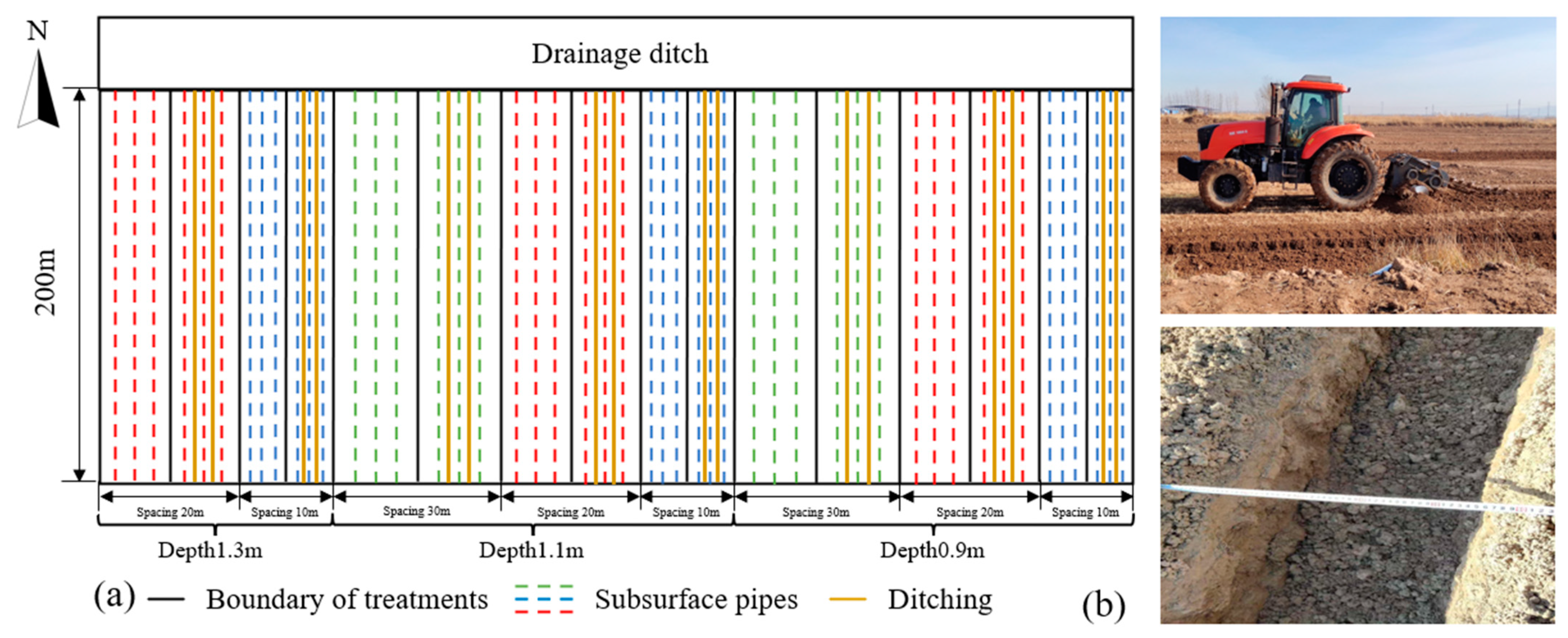
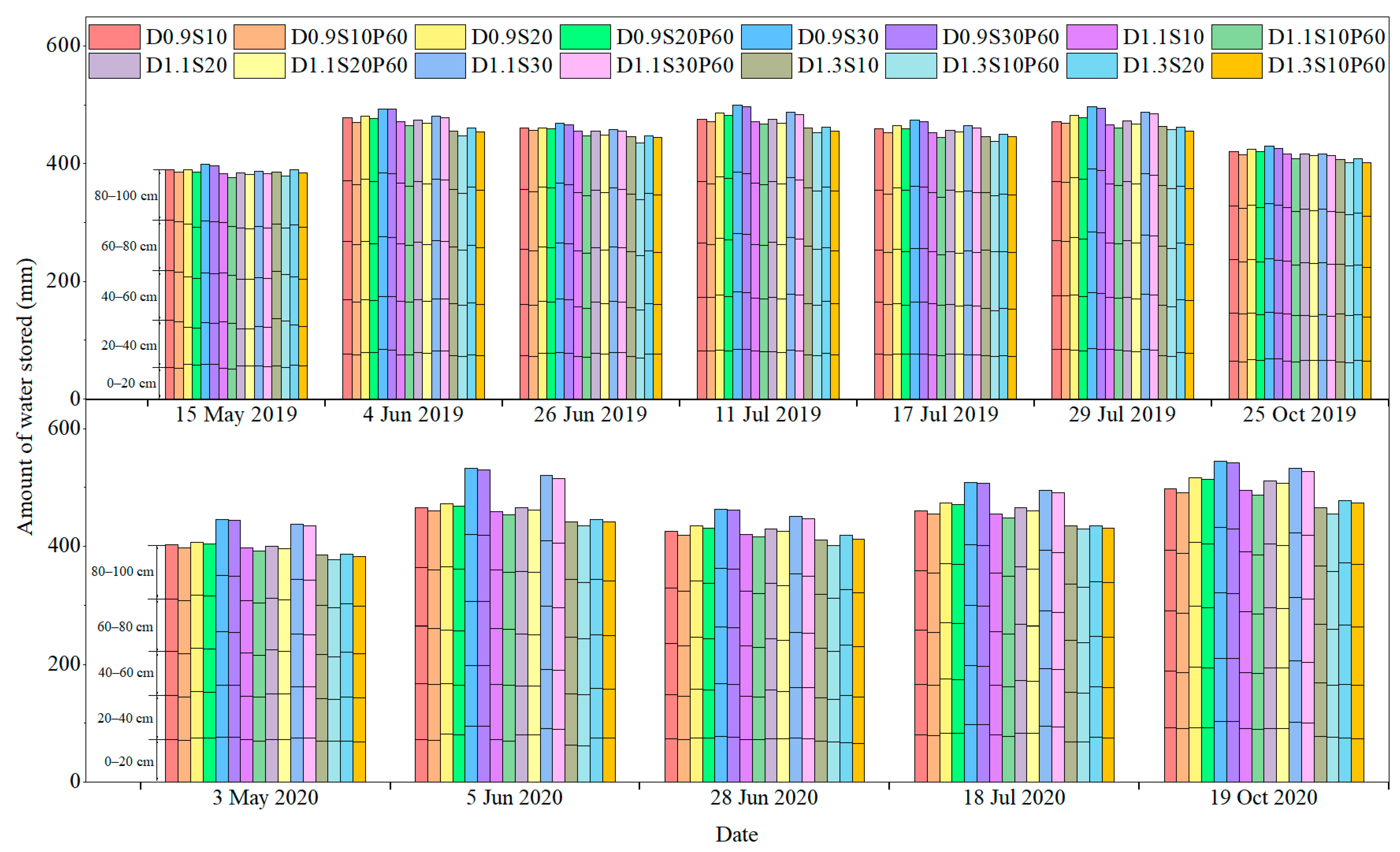
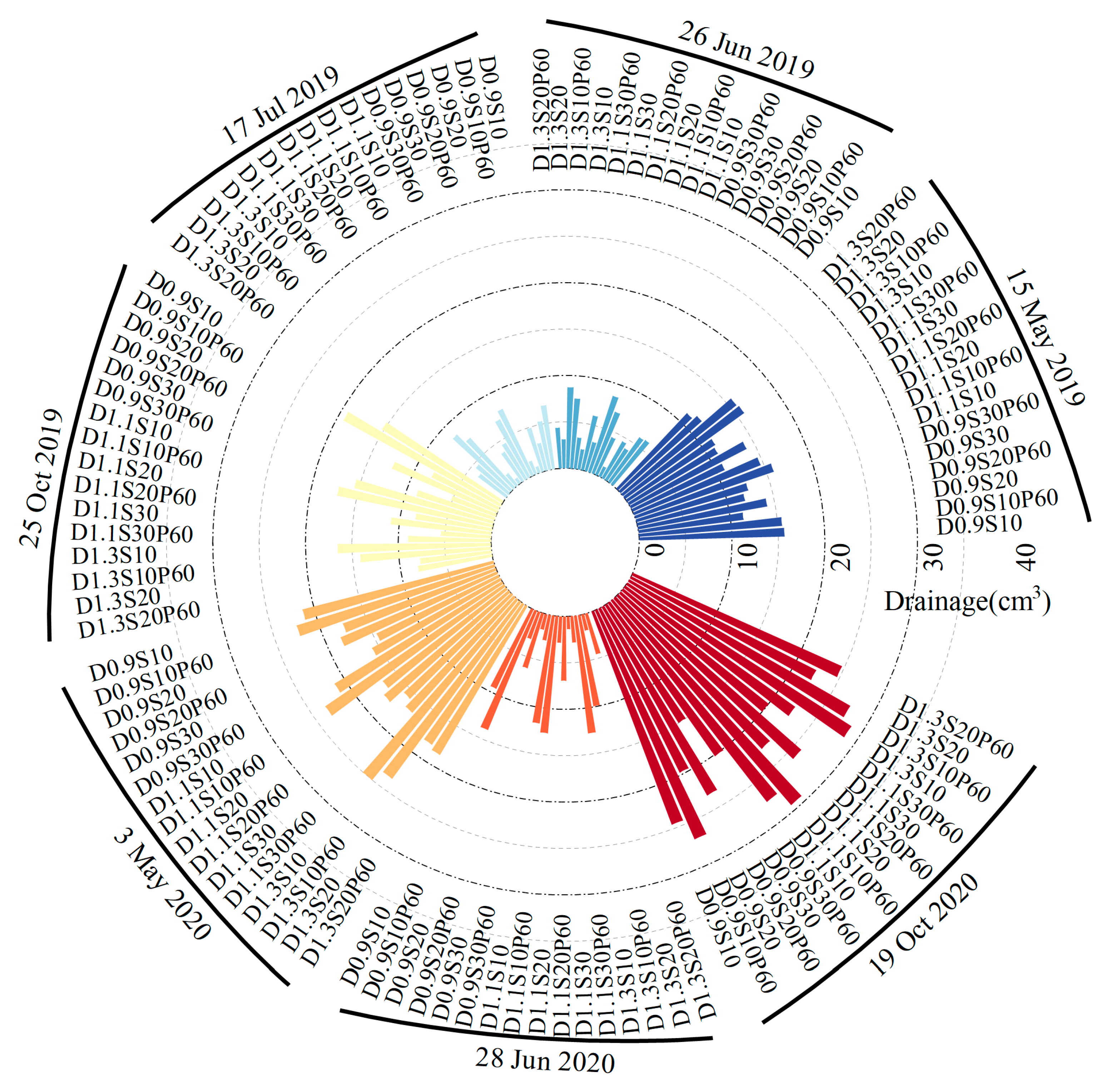
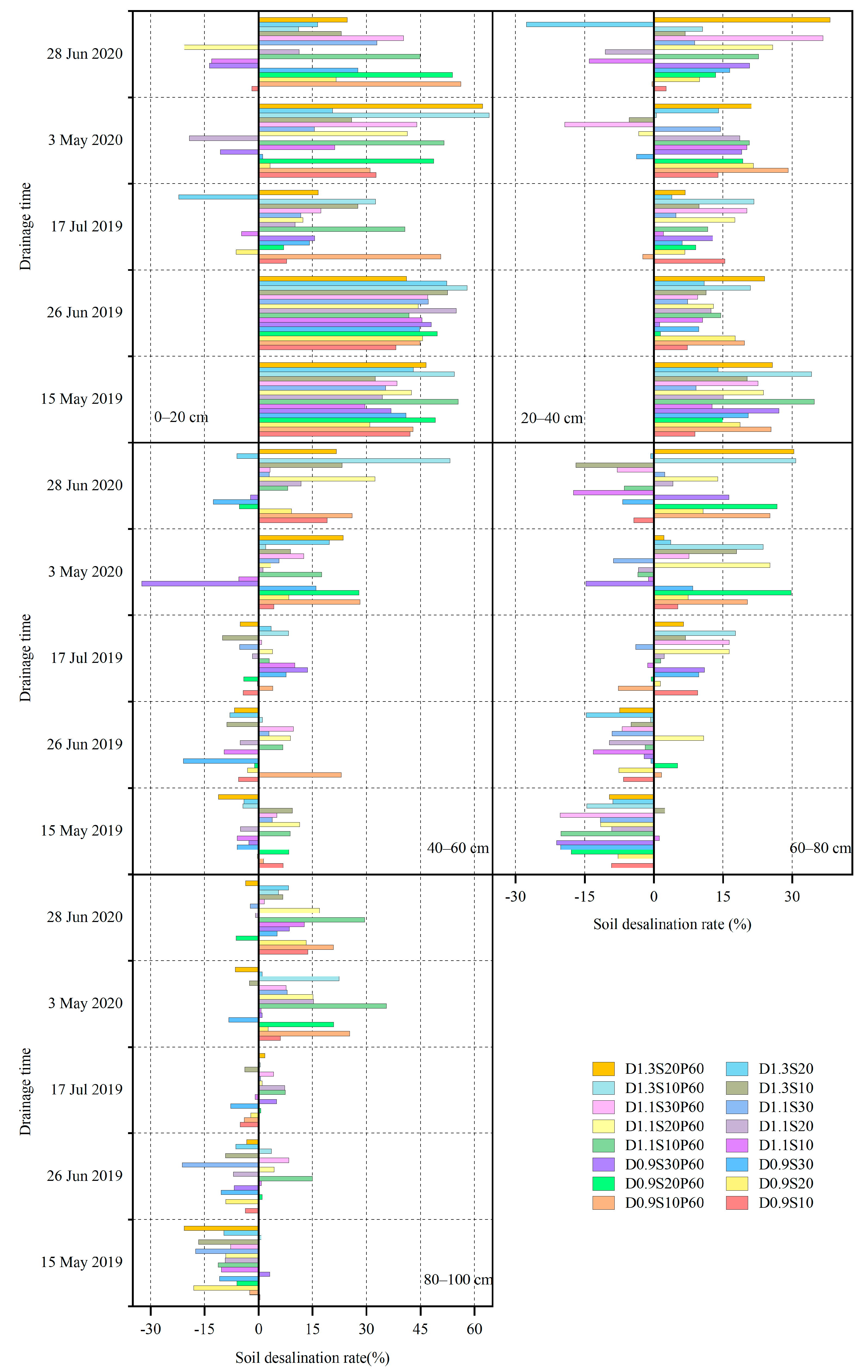
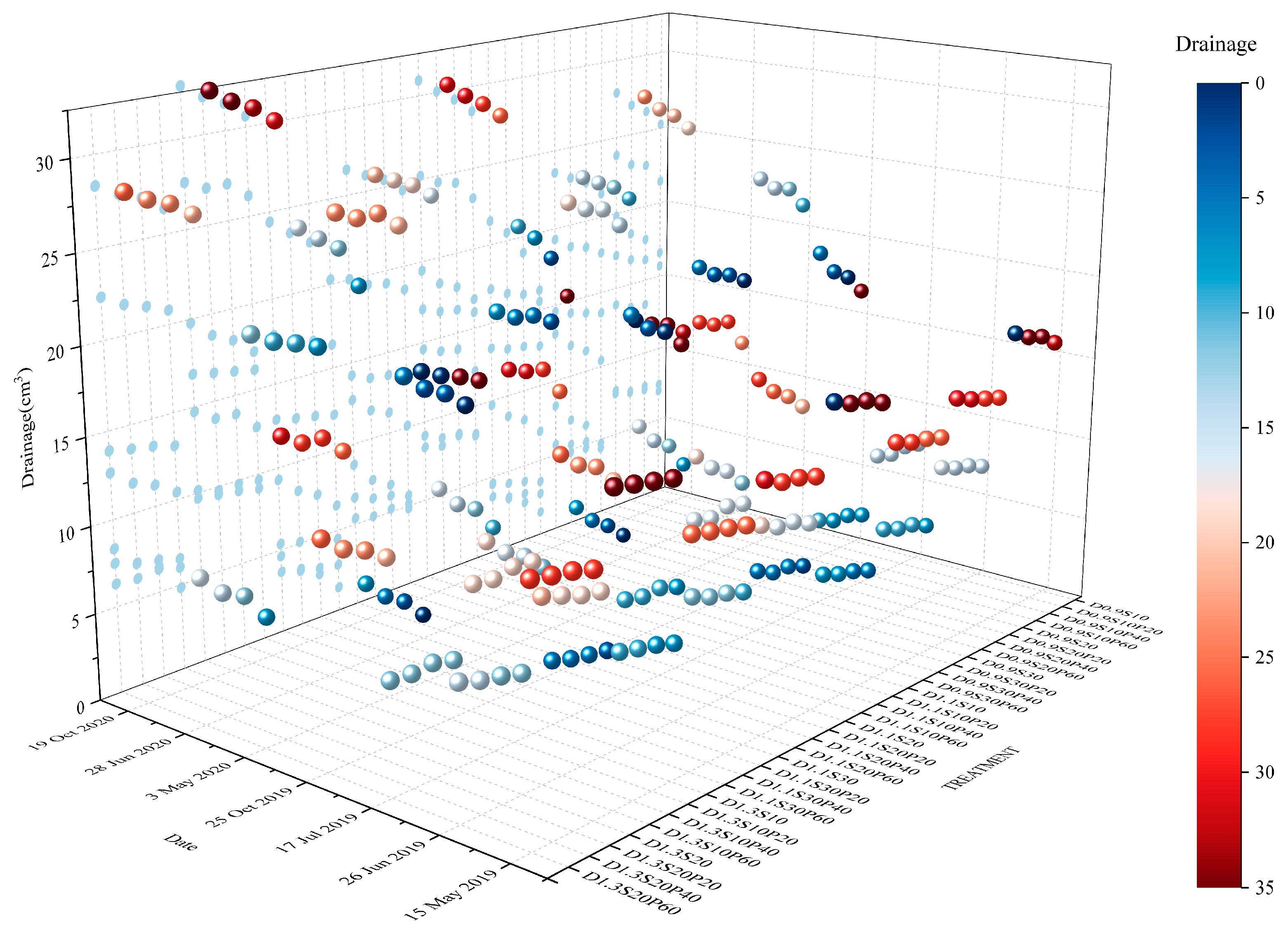

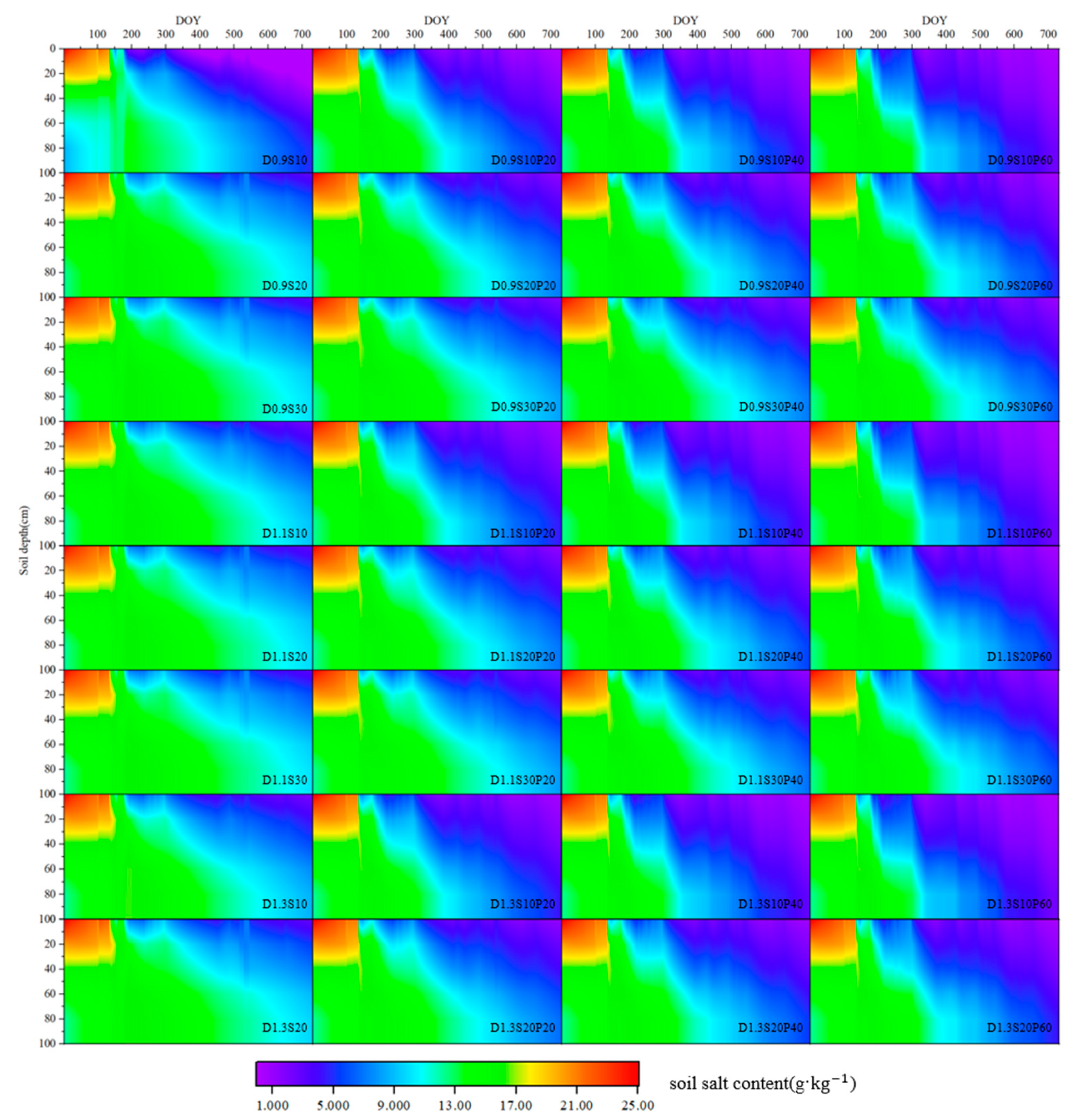
| Soil Layer (cm) | Particle Composition/% | Bulk Density (g cm−3) | Soil Salt Content (g kg−1) | Field Capacity (cm3 cm−3) | ||
|---|---|---|---|---|---|---|
| Sand | Clay | Silt | ||||
| 0–20 | 9.46 | 9.04 | 81.50 | 1.46 | 23.51 | 0.331 |
| 20–40 | 21.98 | 12.51 | 65.51 | 1.46 | 18.22 | 0.352 |
| 40–60 | 25.27 | 14.14 | 60.59 | 1.49 | 15.53 | 0.355 |
| 60–80 | 3.36 | 10.70 | 85.94 | 1.50 | 11.79 | 0.362 |
| 80–100 | 25.91 | 13.37 | 60.72 | 1.51 | 10.60 | 0.367 |
| Parameters | Intelligence Group | Calibration Parameter Values | Unit |
|---|---|---|---|
| Climate | Maximum and minimum daily temperatures | The micro weather station (HOBO-U30) | °C |
| Amount of rain daily | The micro weather station (HOBO-U30) | mm | |
| PET | Penman–Monteith | mm | |
| Soil | Transverse saturated hydraulic conductivity (0–20 cm) | 1.6 | mm h−1 |
| Transverse saturated hydraulic conductivity (20–40 cm) | 1.4 | mm h−1 | |
| Transverse saturated hydraulic conductivity (40–60 cm) | 1.4 | mm h−1 | |
| Transverse saturated hydraulic conductivity (60–80 cm) | 0.8 | mm h−1 | |
| Transverse saturated hydraulic conductivity (80–100 cm) | 1.2 | mm h−1 | |
| Depth of impenetrable layer | 2 | m | |
| Soil water characteristic | Measured by the laboratory | cm3 cm−3 | |
| Initial soil salinity | Field measured values (Table 1) | g kg−1 | |
| Drainage system | Drainage depth | Layout of each test plot | cm |
| Drainage spacing | Layout of each test plot | cm | |
| Effective drainage radius | 1.5 | cm | |
| Maximum surface water storage depth | 18 | cm | |
| Initial groundwater level depth | 160 | cm | |
| Drainage coefficient | 14 | mm day−1 | |
| Kirkham’s depth for flow to drains | 0.3 | cm | |
| Water | Amount of irrigation water | Actual irrigation quota | m3 ha−1 |
| Average of irrigation water salinity | 0.67 | g kg−1 |
| Treatment | Soil Layer (cm) | R2 (-) | MAE (cm) | RMSE (cm) | Treatment | Soil Layer (cm) | R2 | MAE (cm) | RMSE (cm) |
|---|---|---|---|---|---|---|---|---|---|
| D0.9S10 | 0–20 | 0.97 | 1.41 | 1.65 | D0.9S10P60 | 0–20 | 0.98 | 1.98 | 2.12 |
| 20–40 | 0.93 | 0.88 | 1.08 | 20–40 | 0.96 | 1.01 | 1.29 | ||
| 40–60 | 0.66 | 1.39 | 1.49 | 40–60 | 0.91 | 1.48 | 1.64 | ||
| 60–80 | 0.72 | 1.27 | 1.43 | 60–80 | 0.51 | 1.92 | 2.11 | ||
| 80–100 | 0.57 | 1.59 | 1.67 | 80–100 | 0.58 | 1.83 | 1.90 | ||
| D0.9S20 | 0–20 | 0.99 | 1.37 | 1.46 | D0.9S20P60 | 0–20 | 0.98 | 1.28 | 1.53 |
| 20–40 | 0.95 | 1.02 | 1.14 | 20–40 | 0.93 | 1.30 | 1.56 | ||
| 40–60 | 0.82 | 1.79 | 1.89 | 40–60 | 0.83 | 1.78 | 1.94 | ||
| 60–80 | 0.82 | 1.42 | 1.45 | 60–80 | 0.76 | 1.85 | 1.90 | ||
| 80–100 | 0.82 | 1.34 | 1.48 | 80–100 | 0.50 | 1.24 | 1.44 | ||
| D0.9S30 | 0–20 | 0.99 | 0.81 | 1.01 | D0.9S30P60 | 0–20 | 0.98 | 1.51 | 1.71 |
| 20–40 | 0.98 | 0.86 | 0.91 | 20–40 | 0.97 | 1.14 | 1.35 | ||
| 40–60 | 0.72 | 0.85 | 1.14 | 40–60 | 0.96 | 1.61 | 1.73 | ||
| 60–80 | 0.46 | 1.35 | 1.57 | 60–80 | 0.33 | 1.62 | 1.84 | ||
| 80–100 | 0.72 | 0.75 | 0.93 | 80–100 | 0.35 | 1.32 | 1.57 | ||
| D1.1S10 | 0–20 | 0.98 | 1.14 | 1.32 | D1.1S10P60 | 0–20 | 0.99 | 1.21 | 1.36 |
| 20–40 | 0.90 | 1.32 | 1.52 | 20–40 | 0.97 | 1.42 | 1.60 | ||
| 40–60 | 0.78 | 1.00 | 1.14 | 40–60 | 0.92 | 1.32 | 1.51 | ||
| 60–80 | 0.72 | 1.40 | 1.49 | 60–80 | 0.68 | 1.56 | 1.73 | ||
| 80–100 | 0.45 | 0.68 | 0.82 | 80–100 | 0.47 | 1.95 | 2.13 | ||
| D1.1S20 | 0–20 | 0.99 | 1.34 | 1.56 | D1.1S20P60 | 0–20 | 0.99 | 0.93 | 1.04 |
| 20–40 | 0.88 | 1.08 | 1.34 | 20–40 | 0.96 | 1.56 | 1.70 | ||
| 40–60 | 0.72 | 1.44 | 1.50 | 40–60 | 0.79 | 1.36 | 1.59 | ||
| 60–80 | 0.93 | 1.26 | 1.30 | 60–80 | 0.61 | 1.23 | 1.49 | ||
| 80–100 | 0.83 | 1.13 | 1.31 | 80–100 | 0.79 | 2.10 | 2.22 | ||
| D1.1S30 | 0–20 | 0.99 | 1.53 | 1.64 | D1.1S30P60 | 0–20 | 0.99 | 1.08 | 1.24 |
| 20–40 | 0.95 | 1.48 | 1.57 | 20–40 | 0.93 | 1.64 | 1.88 | ||
| 40–60 | 0.69 | 1.26 | 1.41 | 40–60 | 0.76 | 1.04 | 1.30 | ||
| 60–80 | 0.61 | 1.53 | 1.63 | 60–80 | 0.72 | 1.59 | 1.83 | ||
| 80–100 | 0.84 | 1.19 | 1.45 | 80–100 | 0.48 | 1.81 | 1.97 | ||
| D1.3S10 | 0–20 | 0.98 | 1.13 | 1.35 | D1.3S10P60 | 0–20 | 0.98 | 0.83 | 1.06 |
| 20–40 | 0.91 | 1.28 | 1.50 | 20–40 | 0.97 | 1.99 | 2.16 | ||
| 40–60 | 0.50 | 1.31 | 1.53 | 40–60 | 0.90 | 1.34 | 1.58 | ||
| 60–80 | 0.46 | 1.62 | 1.73 | 60–80 | 0.75 | 1.34 | 1.52 | ||
| 80–100 | 0.86 | 1.36 | 1.54 | 80–100 | 0.67 | 1.20 | 1.30 | ||
| D1.3S20 | 0–20 | 0.96 | 1.22 | 1.52 | D1.3S20P60 | 0–20 | 0.99 | 1.38 | 1.63 |
| 20–40 | 0.96 | 0.83 | 0.98 | 20–40 | 0.96 | 1.68 | 1.83 | ||
| 40–60 | 0.51 | 0.87 | 1.03 | 40–60 | 0.77 | 1.26 | 1.54 | ||
| 60–80 | 0.61 | 0.81 | 1.03 | 60–80 | 0.54 | 1.36 | 1.62 | ||
| 80–100 | 0.95 | 0.77 | 0.79 | 80–100 | 0.97 | 1.59 | 1.75 |
| Treatment | Soil Layer (cm) | R2 | MAE (cm) | RMSE (cm) | Treatment | Soil Layer (cm) | R2 | MAE (cm) | RMSE (cm) |
|---|---|---|---|---|---|---|---|---|---|
| D0.9S10 | 0–20 | 0.70 | 0.95 | 1.13 | D0.9S10P60 | 0–20 | 0.86 | 1.63 | 1.81 |
| 20–40 | 0.55 | 0.74 | 0.90 | 20–40 | 0.78 | 0.99 | 1.12 | ||
| 40–60 | 0.75 | 0.94 | 1.12 | 40–60 | 0.64 | 1.25 | 1.47 | ||
| 60–80 | 0.80 | 0.51 | 0.65 | 60–80 | 0.84 | 1.08 | 1.32 | ||
| 80–100 | 0.66 | 0.87 | 1.04 | 80–100 | 0.96 | 1.31 | 1.47 | ||
| D0.9S20 | 0–20 | 0.84 | 0.93 | 1.02 | D0.9S20P60 | 0–20 | 0.89 | 1.35 | 1.51 |
| 20–40 | 0.64 | 1.61 | 1.77 | 20–40 | 0.70 | 1.23 | 1.38 | ||
| 40–60 | 0.70 | 1.13 | 1.20 | 40–60 | 0.79 | 0.75 | 0.97 | ||
| 60–80 | 0.87 | 1.55 | 1.68 | 60–80 | 0.66 | 1.26 | 1.56 | ||
| 80–100 | 0.84 | 1.51 | 1.77 | 80–100 | 0.82 | 1.08 | 1.29 | ||
| D0.9S30 | 0–20 | 0.96 | 0.65 | 0.74 | D0.9S30P60 | 0–20 | 0.92 | 1.77 | 1.96 |
| 20–40 | 0.56 | 0.92 | 1.19 | 20–40 | 0.91 | 1.29 | 1.43 | ||
| 40–60 | 0.60 | 1.04 | 1.16 | 40–60 | 0.20 | 0.93 | 1.26 | ||
| 60–80 | 0.74 | 1.14 | 1.23 | 60–80 | 0.63 | 0.81 | 1.15 | ||
| 80–100 | 0.51 | 1.56 | 1.65 | 80–100 | 0.78 | 1.11 | 1.25 | ||
| D1.1S10 | 0–20 | 0.63 | 1.23 | 1.41 | D1.1S10P60 | 0–20 | 0.69 | 1.01 | 1.11 |
| 20–40 | 0.69 | 1.55 | 1.68 | 20–40 | 0.63 | 0.64 | 0.77 | ||
| 40–60 | 0.78 | 0.91 | 0.99 | 40–60 | 0.89 | 0.72 | 0.78 | ||
| 60–80 | 0.64 | 1.11 | 1.40 | 60–80 | 0.60 | 1.32 | 1.48 | ||
| 80–100 | 0.72 | 0.91 | 1.04 | 80–100 | 0.82 | 1.19 | 1.51 | ||
| D1.1S20 | 0–20 | 0.62 | 1.53 | 1.65 | D1.1S20P60 | 0–20 | 0.61 | 1.29 | 1.38 |
| 20–40 | 0.54 | 1.33 | 1.44 | 20–40 | 0.81 | 1.99 | 2.07 | ||
| 40–60 | 0.35 | 0.77 | 0.92 | 40–60 | 0.70 | 1.01 | 1.13 | ||
| 60–80 | 0.86 | 1.65 | 1.71 | 60–80 | 0.81 | 1.36 | 1.55 | ||
| 80–100 | 0.76 | 0.96 | 1.16 | 80–100 | 0.92 | 1.71 | 1.78 | ||
| D1.1S30 | 0–20 | 0.81 | 1.27 | 1.40 | D1.1S30P60 | 0–20 | 0.52 | 1.19 | 1.50 |
| 20–40 | 0.62 | 1.23 | 1.30 | 20–40 | 0.51 | 1.34 | 1.62 | ||
| 40–60 | 0.55 | 1.17 | 1.38 | 40–60 | 0.87 | 0.70 | 0.80 | ||
| 60–80 | 0.69 | 1.55 | 1.82 | 60–80 | 0.75 | 0.70 | 0.83 | ||
| 80–100 | 0.42 | 1.21 | 1.40 | 80–100 | 0.75 | 0.76 | 1.04 | ||
| D1.3S10 | 0–20 | 0.93 | 0.56 | 0.63 | D1.3S10P60 | 0–20 | 0.82 | 0.88 | 1.17 |
| 20–40 | 0.72 | 0.82 | 0.92 | 20–40 | 0.58 | 1.37 | 1.66 | ||
| 40–60 | 0.57 | 1.23 | 1.42 | 40–60 | 0.42 | 1.76 | 1.97 | ||
| 60–80 | 0.59 | 1.07 | 1.41 | 60–80 | 0.97 | 1.28 | 1.34 | ||
| 80–100 | 0.72 | 1.07 | 1.16 | 80–100 | 0.90 | 1.06 | 1.19 | ||
| D1.3S20 | 0–20 | 0.68 | 0.90 | 1.09 | D1.3S20P60 | 0–20 | 0.88 | 0.98 | 1.29 |
| 20–40 | 0.52 | 1.21 | 1.43 | 20–40 | 0.41 | 1.25 | 1.37 | ||
| 40–60 | 0.57 | 1.45 | 1.71 | 40–60 | 0.84 | 1.52 | 1.61 | ||
| 60–80 | 0.86 | 1.37 | 1.40 | 60–80 | 0.72 | 1.54 | 1.69 | ||
| 80–100 | 0.78 | 1.65 | 1.69 | 80–100 | 0.61 | 1.32 | 1.51 |
Disclaimer/Publisher’s Note: The statements, opinions and data contained in all publications are solely those of the individual author(s) and contributor(s) and not of MDPI and/or the editor(s). MDPI and/or the editor(s) disclaim responsibility for any injury to people or property resulting from any ideas, methods, instructions or products referred to in the content. |
© 2023 by the authors. Licensee MDPI, Basel, Switzerland. This article is an open access article distributed under the terms and conditions of the Creative Commons Attribution (CC BY) license (https://creativecommons.org/licenses/by/4.0/).
Share and Cite
Tian, F.; Shi, H.; Miao, Q.; Li, R.; Duan, J.; Dou, X.; Feng, W. Soil Water and Salt Transport in Severe Saline–Alkali Soil after Ditching under Subsurface Pipe Drainage Conditions. Agriculture 2023, 13, 2196. https://doi.org/10.3390/agriculture13122196
Tian F, Shi H, Miao Q, Li R, Duan J, Dou X, Feng W. Soil Water and Salt Transport in Severe Saline–Alkali Soil after Ditching under Subsurface Pipe Drainage Conditions. Agriculture. 2023; 13(12):2196. https://doi.org/10.3390/agriculture13122196
Chicago/Turabian StyleTian, Feng, Haibin Shi, Qingfeng Miao, Ruiping Li, Jie Duan, Xu Dou, and Weiying Feng. 2023. "Soil Water and Salt Transport in Severe Saline–Alkali Soil after Ditching under Subsurface Pipe Drainage Conditions" Agriculture 13, no. 12: 2196. https://doi.org/10.3390/agriculture13122196
APA StyleTian, F., Shi, H., Miao, Q., Li, R., Duan, J., Dou, X., & Feng, W. (2023). Soil Water and Salt Transport in Severe Saline–Alkali Soil after Ditching under Subsurface Pipe Drainage Conditions. Agriculture, 13(12), 2196. https://doi.org/10.3390/agriculture13122196








